Microsoft Edge is one of the best web browsers for Windows 11/10. Apart from a fast browsing experience, it also offers users safe and secure web browsing. Some users have experienced an issue with Microsoft Edge. According to them, Microsoft Edge crashes when playing a video on YouTube, Vimeo, or on any other similar platform. Some users have experienced problems viewing a video in full-screen mode in Edge. If such issues occur on your computer, you can try the solutions provided in this article.
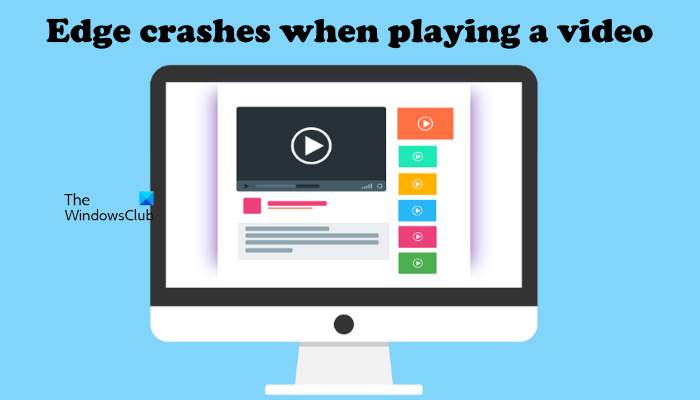
Microsoft Edge crashes when playing a video
If Edge browser crashes when playing a video on your system, the following suggestions may help you eliminate the problem. Before you begin, manually check for Windows Updates and install them if any are offered – including Driver updates.
- Clear Edge cache and cookies
- Identify the problematic extension
- Disable hardware acceleration in Edge
- Enable software rendering on your system
- Change Edge Flags setting
- Reset Edge settings to default
- Uninstall and reinstall Edge
Let’s see all these solutions in detail.
1] Clear Edge cache and cookies
Sometimes the problem occurs due to a web browser’s corrupted cache and cookie data. This might be the case with you. You can check this by deleting the cache and cookies in Edge. To do so, follow the steps below:
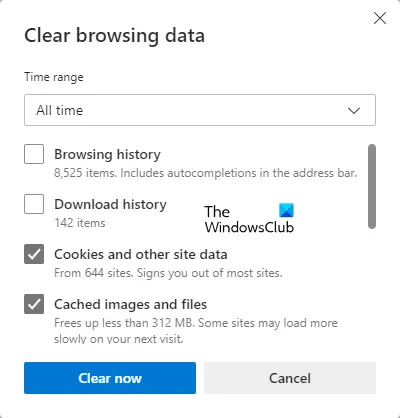
- Click on the three horizontal dots on the top right side and select Settings.
- Select Privacy, search, and services from the left side.
- Scroll down and click on the Choose what to clear button under the Clear browsing data section.
- The Clear browsing data window will appear. Select All time in the Time range drop-down.
- Deselect everything except the following two options:
- Cookie and other site data.
- Cached images and files.
- Click Clear now.
2] Identify the problematic extension
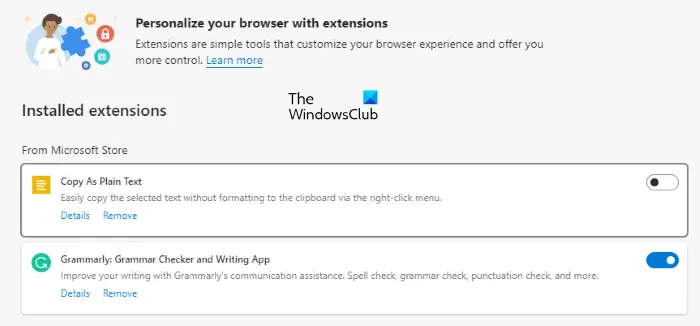
Check if the issue occurs due to an extension installed in the Edge browser. To do so, disable all the extensions and then play the video. See if Edge crashes this time. If not, one of the extensions is the culprit. Now, you have to identify that problematic extension. For this, start enabling the disabled extensions individually and play a video whenever you enable an extension. This process will take time but help you identify the problematic extension. Once you find the problematic extension, remove it from Edge.
To disable extensions, open a new tab in Edge and type edge://extensions. After that hit Enter. Now, turn off the button next to all the extensions. This action will disable the extensions in Edge.
Read: Microsoft Edge crashes when printing
3] Disable hardware acceleration in Edge
If the above fixes did not help you, the problem might be caused by Edge’s hardware graphics acceleration. To check this, disable Edge’s hardware acceleration (if you enabled it before) and then play a video. Now, see if Edge crashes this time. If the issue disappears after disabling Edge’s hardware acceleration, keep this option disabled.
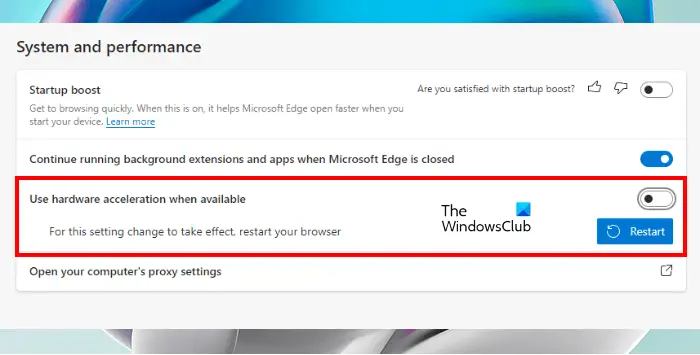
The following instructions will guide you on how to disable hardware acceleration in Edge.
- Open Edge Settings.
- Select System and Performance from the left pane.
- Under the System section, turn off the button next to the “Use hardware acceleration when available” option.
- Restart Edge.
4] Enable software rendering on your system
This solution has helped many users. You can also try this if the problem still persists. Enable the software rendering on your system and see if this fixes the problem. The steps for the same are written below:
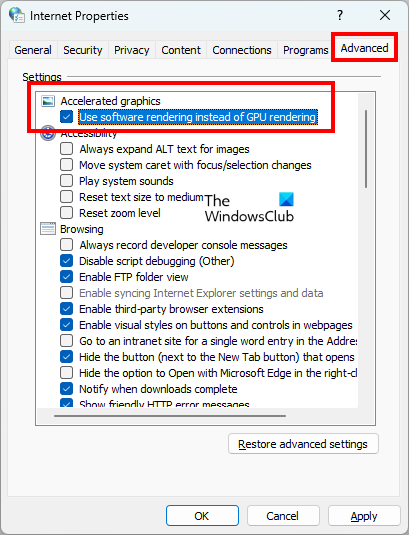
- Click on Windows Search and type internet options.
- Select Internet Options from the search results. This will open the Internet Properties window.
- Select the Advanced tab.
- Under the Accelerated graphics branch, enable the “Use software rendering instead of GPU rendering” checkbox.
- Click Apply and then click OK.
5] Change Edge Flags
The graphics backend feature in Edge is used to boost performance. If you are experiencing frequent crashes in Edge while playing a video, set the ANGLE graphics backend Edge Flag to D3D11on12. To do so, follow the instructions given below:
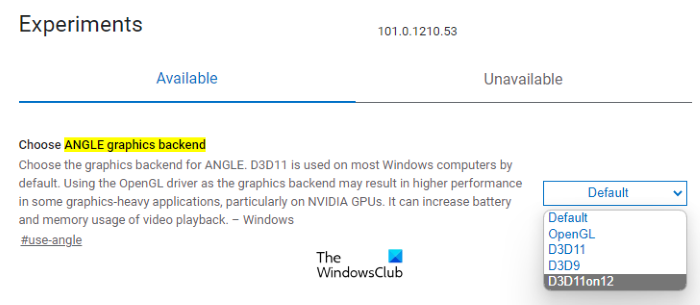
- Open a new tab in Edge and type edge://flags. Press Enter.
- The Experiments page will open in Edge. Type angle graphics backend in the search bar.
- Click on the Choose ANGLE graphics backend drop-down and select D3D11on12.
- Restart Edge.
This should fix the problem. If not, try the next solution.
6] Reset Edge settings to default
Resetting the Edge settings to default works when you are experiencing issues with it like it is not working properly, not responding, or crashing frequently. This action will reset your startup page, new tab page, search engine, and pinned tabs, and also clear your temporary data like cookies. Your extensions will also be disabled after resetting the Edge settings to default but your history and saved passwords will not be cleared.
Reset the Edge settings to default and see if it helps.
7] Uninstall and reinstall Edge
If nothing helped you fix the problem, uninstall Edge. If you open the Apps & Features page in Windows 11/10 Settings, you will see that the Uninstall option for Microsoft Edge is greyed out. Therefore, you cannot uninstall it via Windows 11/10 Settings. Hence, you have to use other ways to uninstall it. You can execute a command in the Command prompt to uninstall Edge from your system. To do so, navigate to the following path in File Explorer.
C:\Program Files (x86)\Microsoft\Edge\Application
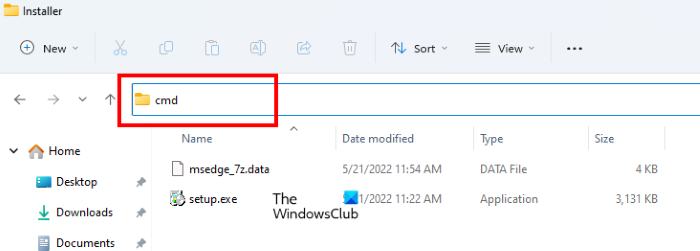
- Now, open the folder that shows the version number of Edge.
- Open the Installer folder.
- Click on the address bar of File Explorer and delete the complete path. After that, type cmd and press Enter. The Command Prompt will appear.
Type the following command and press Enter.
setup.exe –uninstall –system-level –verbose-logging –force-uninstall
After uninstalling Edge, visit microsoft.com and download the latest version of Edge and install it on your system.
Read: Microsoft Edge keeps opening automatically by itself.
Why does my Edge keep crashing?
If Edge keeps crashing, the problem might be occurring due to corrupted cache data. In this case, the problem can be fixed by deleting Edge’s cache and cookie data. Another cause of the problem is a problematic extension. Launch Edge in InPrivate mode to confirm this and see if it crashes. If not, an extension is causing the problem. Open the Manage Extensions page in Edge and disable an extension, and monitor for some time if Edge crashes. Repeat the process till you find the problematic extension. Once you identify the culprit, consider removing it from Edge.
If this does not work, repair Edge. To do so, open the Apps & Features page in Windows 11/10 Settings and locate Microsoft Edge. Select it and click Advanced options. Now, click Repair.
Why are videos not playing on Microsoft Edge?
If videos are not playing on Microsoft Edge or if Edge is crashing while playing videos, the problem might occur due to an extension. Launch Edge in InPrivate mode to identify this and check if you can play videos. If yes, the problem is caused by an extension. Now, launch Edge in normal mode and start disabling extensions one by one. Play video after disabling each extension. In this way, you can identify the problematic extension.
Other causes of this problem are hardware acceleration in Edge, corrupted Edge cache and cookie data, and other issues. To fix the problem, disable hardware acceleration in Edge and clear cache and cookie data.
Read: How to play Video in Full-screen Mode in Edge browser
Why does my Edge keep blacking out?
The blank white or black screen problem in Edge might be occurring due to hardware acceleration. If you have enabled the hardware acceleration in Edge, disable it. First, launch Task Manager and end the sub-processes of Edge one by one until the Edge interface becomes visible. Once the black screen goes out, disable hardware acceleration.
Another cause of the issue is the corrupted graphics card driver. Update your graphics card driver and see if it helps. It would be best if you also scanned your computer with good antivirus software. If nothing helps, reset or repair Edge.
I hope this helps.
Read next: Fix Microsoft Edge not displaying web pages or text correctly.
Leave a Reply